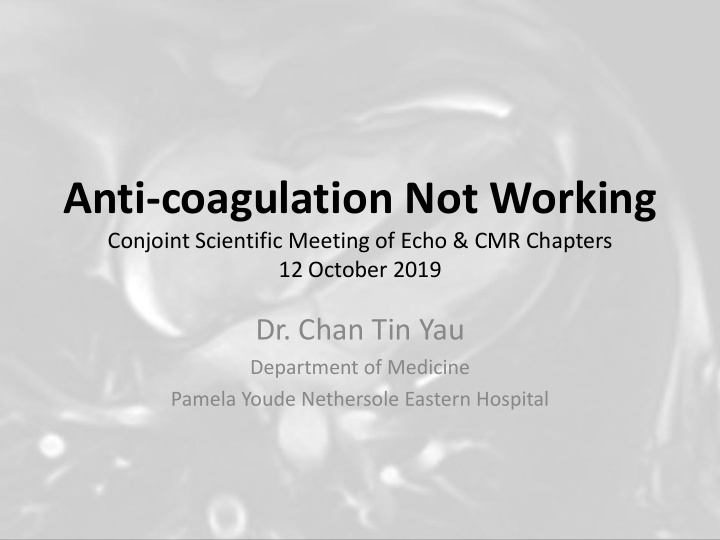



Anti-coagulation Not Working Conjoint Scientific Meeting of Echo & CMR Chapters 12 October 2019 Dr. Chan Tin Yau Department of Medicine Pamela Youde Nethersole Eastern Hospital
• F/63 • Non-smoker, non-drinker • Good Past health • Incidental finding of AF during an admission to Surgery for abdominal pain • No cardiac symptoms
• Trans-Thoracic Echo – A mobile echogenic mass (2.1 x 2.8 x 2.5cm) – Attaching IAS in LA – No mitral inflow obstruction LA thrombus
• Trans-Esophageal Echo – Solitary mass (3.6 x 2.3cm) – Attached to IAS – No stalk – Clear LAA and RA
• MRI Cardiac – Mildly lobulated contour (3.3cm x 3.1cm x 2.7cm) in LA, abutting the IAS – Predominantly low signal in T1 & STIR images – No substantial contrast enhancement in early and late gadolinium imaging – No frank adhesion to mitral valve
• MRI Cardiac – Mildly lobulated contour (3.3cm x 3.1cm x 2.7cm) in LA, abutting the IAS – Predominantly low signal in T1 & STIR images – No substantial contrast enhancement in early and late gadolinium imaging – No frank adhesion to mitral valve
• MRI Cardiac – Mildly lobulated contour (3.3cm x 3.1cm x 2.7cm) in LA, abutting the IAS – Predominantly low signal in T1 & STIR images – No substantial contrast enhancement in early and late gadolinium imaging – No frank adhesion to mitral valve
• MRI Cardiac – Mildly lobulated contour (3.3cm x 3.1cm x 2.7cm) in LA, abutting the IAS – Predominantly low signal in T1 & STIR images – No substantial contrast enhancement in early and late gadolinium imaging – No frank adhesion to mitral valve
• MRI Cardiac – Mildly lobulated contour (3.3cm x 3.1cm x 2.7cm) in LA, abutting the IAS – Predominantly low signal in T1 & STIR images – No substantial contrast enhancement in early and late gadolinium imaging – No frank adhesion to mitral valve
• MRI Cardiac – Mildly lobulated contour (3.3cm x 3.1cm x 2.7cm) in LA, abutting the IAS – Predominantly low signal in T1 & STIR images – No substantial contrast enhancement in early and late gadolinium imaging – No frank adhesion to mitral valve
• MRI Cardiac – Mildly lobulated contour (3.3cm x 3.1cm x 2.7cm) in LA, abutting the IAS – Predominantly low signal in T1 & STIR images – No substantial contrast enhancement in early and late gadolinium imaging – No frank adhesion to mitral valve Favour of thrombus
• Anti-coagulation started • TTE (3 months later) showed similar LA mass – Longer duration of adequate anti-coagulation
• After 1 year of anti-coagulation • LA mass did not decrease in size Refer CTSU
DISCUSSION
MRI Basics • Relative signal intensity in MR – Proton density – T1 and T2 relaxation times • Different tissues different relaxation times – Different internal biochemical environments
Imaging modality • T1-weighted – Fat • T2-weighted – Edema – Liquefactive necrosis
Imaging modality • First-pass Perfusion – Vascularity of cardiac mass • Vascular tumors signal intensity enhancement – Heterogeneous enhancement • Vascularity variations
Imaging modality • Early Gadolinium Enhancement – Optimal technique for thrombus – Blood pool and myocardium have intermediate signal intensity • Thrombus no contrast uptake
Imaging modality • Late Gadolinium Enhancement – Detect myocardial infarction • Over time contrast wash out • Persist in expanded interstitial space – Cellular breakdown permit gadolinium intracellular
THROMBUS VS MYXOMA
Thrombus • Pseudotumour • Typically in left atrium – Atrial fibrillation – Mitral valve disease • Severely dysfunctional left ventricles following myocardial infarction
Signal Intensity for Thrombus Age of T1-weighted T2-weighted Early Late thrombus Gadolinium Gadolinium Acute Intermediate Intermediate No uptake Subacute Low High Chronic Low Low Haemoglobin is still in oxygenated state
Signal Intensity for Thrombus Age of T1-weighted T2-weighted Early Late thrombus Gadolinium Gadolinium Acute Intermediate Intermediate No uptake Subacute Low High Chronic Low Low Haemoglobin metabolized to methaemoglobin Different paramagnetic effect High water content from lysed RBC
Signal Intensity for Thrombus Age of T1-weighted T2-weighted Early Late thrombus Gadolinium Gadolinium Acute Intermediate Intermediate No uptake Subacute Low High Chronic Low Low Thrombus water-depleted Cellular debris replaced by fibrous tissue greater fibrin content
Signal Intensity for Thrombus Age of T1-weighted T2-weighted Early Late thrombus Gadolinium Gadolinium Acute Intermediate Intermediate No uptake Subacute Low High Chronic Low Low Enables clear differentiation of thrombus -Thrombus is avascular -Absence contrast uptake
Thrombus Association • Prevalence of thrombus – Worsening left ventricular ejection fraction – Ischemic etiology – Myocardial scarring • Additional value to characterise suspected thrombus in coronary artery disease
Benign Pedunculated Most common Myxoma Well defined, Fourth to smooth, seventh lobular or oval decade Interatrial Solitary, vary septum in size
Myxoma • Sporadic occurrence • Asymptomatic if small • Symptoms – Mass effect – Embolization – Constitutional symptoms • Surgical resection – 13% recurrence after resection
Signal Intensity for Myxoma T1-weighted T2-weighted Myxoma Isointense High Regions of acute haemorrhage Low Low • Cine imaging – Highly mobile – Prolapse through mitral valve • Heterogenous contrast enhancement • Layer of surface thrombus – Low signal intensity on late gadolinium
WHAT IS NOT SO COMMON IN OUR CASE?
• From MRI, the mass was not highly mobile
• From MRI and Operation record, the mass had wide base Compared with usual pedunculated apperance
WHAT CAN WE DO BETTER?
• MRI Cardiac – Mildly lobulated contour (3.3cm x 3.1cm x 2.7cm) in LA, abutting the IAS – Predominantly low signal in T1 & STIR images Heterogenous signal – No substantial contrast enhancement in early and late gadolinium imaging – No frank adhesion to mitral valve
• MRI Cardiac – Mildly lobulated contour (3.3cm x 3.1cm x 2.7cm) in LA, abutting the IAS – Predominantly low signal in T1 & STIR images – No substantial contrast enhancement in early and late gadolinium imaging – No frank adhesion to mitral valve First-pass perfusion imaging to be done
Anti-coagulation Not Working Think about other possibilities
Thank you
Recommend
More recommend